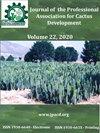Applying an alginate and mucilage-based edible coating to avocado halves favors some physical attributes and consumer acceptance
IF 0.4
4区 农林科学
Q4 HORTICULTURE
Journal of the Professional Association for Cactus Development
Pub Date : 2023-12-21
DOI:10.56890/jpacd.v25i.530
引用次数: 0
Abstract
The avocado is a highly perishable fruit, leading to significant potential waste and loss in some links of the agri-food chain, with negative environmental and economic impacts. This study explored the influence of an alginate and mucilage-based edible coating on some physical attributes, cold storage, and consumer acceptance of avocado halves coated at the ready-to-eat stage. Two lots of avocado halves were formed. One was treated with an edible coating formulated from alginate and mucilage; the other was uncoated. Uncoated and coated avocado halves were cold-stored at 4 ± 1 °C and 95% relative humidity for 12 d. The fruit mass loss (FML), fresh firmness (FF), and some color parameters were measured every other day. The experiment was conducted in a completely random design with three replicates at each sampling date. On the sixth day, a sensory study was performed with 30 untrained panelists who were frequent avocado eaters. The coated avocado halves were brighter, redder, and yellower during the experimental period than uncoated avocado halves. A significant color differences (?E*) were found between coated and uncoated avocado halves. At the end of the experiment, the coated samples had the lowest FML and FF and the greatest consumer acceptance. Therefore, the edible coating presented here is a feasible technology for minimally-processed avocado halves and for high-latitude markets, where this fruit is scarce.在牛油果半果上涂抹海藻酸盐和粘液质食用涂层,有利于提高某些物理属性和消费者接受度
牛油果是一种极易变质的水果,在农业食品链的某些环节可能会造成巨大的浪费和损失,对环境和经济造成负面影响。本研究探讨了基于海藻酸盐和粘液质的可食用涂层对即食阶段涂有涂层的牛油果半果的一些物理属性、冷藏和消费者接受程度的影响。牛油果半成品分为两批。其中一批用海藻酸盐和粘液质配制的可食用涂层进行处理,另一批则没有涂层。每隔一天测量一次果实质量损失(FML)、新鲜度(FF)和一些颜色参数。实验采用完全随机设计,每个采样日期有三个重复。第六天,对 30 位经常食用牛油果的未经培训的评委进行了感官研究。在实验期间,有涂层的牛油果比无涂层的牛油果更亮、更红、更黄。涂过涂层和未涂过涂层的牛油果半片之间存在明显的颜色差异(?E*)。实验结束时,涂过涂层的样品的 FML 和 FF 最低,消费者的接受度最高。因此,本文介绍的可食用涂层是一种可行的技术,可用于牛油果半片的微加工和高纬度市场,因为这种水果在高纬度市场非常稀缺。
本文章由计算机程序翻译,如有差异,请以英文原文为准。
求助全文
约1分钟内获得全文
求助全文
来源期刊

Journal of the Professional Association for Cactus Development
Agricultural and Biological Sciences-Plant Science
CiteScore
1.10
自引率
33.30%
发文量
10
期刊介绍:
The editors of the Journal of the Professional Association for Cactus Development, are very excited to be a part of the excellent editorial committee and to work together to create the synergism between scientists, growers, legislators, and business people so vital to the development of this industry to serve the people of arid lands.
 求助内容:
求助内容: 应助结果提醒方式:
应助结果提醒方式:


